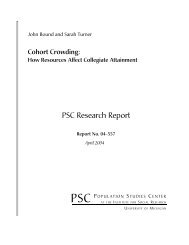Tracking metropolitan America into the 21st century - Population ...
Tracking metropolitan America into the 21st century - Population ...
Tracking metropolitan America into the 21st century - Population ...
Create successful ePaper yourself
Turn your PDF publications into a flip-book with our unique Google optimized e-Paper software.
18. Of <strong>the</strong> 22 metro areas under <strong>the</strong> old systemthat have combined in <strong>the</strong> new system,fully seven are located in <strong>the</strong> New Yorkregion.19. This change has brought recognition tolarge suburban economic centers and hasbrought places <strong>into</strong> titles that never wouldhave been able to qualify in <strong>the</strong> past (forinstance, Paradise, NV; Sandy Springs, GA;and Towson, MD).20. Additional principal cities within a <strong>metropolitan</strong>area include any with more than250,000 people or 100,000 workers. Placeswith more than 50,000 can also be principalcities if <strong>the</strong> number of jobs located<strong>the</strong>re meets or exceeds <strong>the</strong> number ofemployed residents. Finally, principal citiesalso include places with more than 10,000people that are at least one-third <strong>the</strong> size of<strong>the</strong> largest place in <strong>the</strong> metro area, andthat have at least as many jobs as employedresidents.21. See, e.g., William H. Frey, “Melting PotSuburbs: A Census 2000 Study of SuburbanDiversity” (Washington: BrookingsInstitution, 2001); Alan Berube andWilliam H. Frey, “A Decade of MixedBlessings: Urban and Suburban Poverty inCensus 2000” (Washington: BrookingsInstitution, 2002); Audrey Singer, “TheRise of New Immigrant Gateways” (Washington:Brookings Institution, 2004).22. See Frey 2004b for a critique of employingthis practice to designate <strong>the</strong> suburbanpopulation.23. At <strong>the</strong> same time, many Brookings analyseshave employed a modified set of centralcities in <strong>the</strong> largest <strong>metropolitan</strong> areas, recognizingonly cities that appear within <strong>the</strong><strong>metropolitan</strong> area name—and in somecases, only those that exceed certain populationthresholds. See, e.g., William H.Frey and Alan Berube, “City Families, SuburbanSingles: An Emerging HouseholdStory from Census 2000” (Washington:Brookings Institution, 2002); Roberto Suroand Audrey Singer, “Latino Growth in Metropolitan<strong>America</strong>: Changing Patterns,New Locations” (Washington: BrookingsInstitution, 2002). This approach discountedsmall employment centers in largeregions, such as Frederick, MD (Washington–BaltimoreCMSA) and Port Huron,MI (Detroit CMSA); future Brookingsanalyses may employ a similar approachwith principal cities.24. There are some exceptions to this rule,where local opinion favored a differentname. See Discussion.25. According to <strong>the</strong> old standards, <strong>metropolitan</strong>area names included <strong>the</strong> largest centralcity and each additional city with at least250,000 persons. Under <strong>the</strong> new standards,<strong>the</strong> names of <strong>the</strong> second and thirdlargest principal cities are included in <strong>metropolitan</strong>area titles.26. Under <strong>the</strong> old standards, Austin and SanMarcos were <strong>the</strong> two central cities in <strong>the</strong>Austin, TX MSA. Round Rock was not acentral city because it did not have anemployment/residence ratio of at least 0.75and at least 40 percent of its employed residentsworking within <strong>the</strong> city. Under <strong>the</strong>new standards, Round Rock qualifies as aprincipal city because its population is over50,000 and its employment/residence ratiois at least 1.0. Because San Marcos’ populationis less than 50,000, and it does nothave both an employment/residence ratioof at least 1.0 and a population of at leastone-third that of Austin’s, it did not qualifyas a principal city and was thus droppedfrom <strong>the</strong> <strong>metropolitan</strong> area title.27. State laws and regulations make use ofOMB-defined <strong>metropolitan</strong> areas as well,but we focus on federal policy here to keep<strong>the</strong> scope reasonable, and to comment onpolicies potentially applicable to all metroareas.28. Many of <strong>the</strong>se special designations affordrural hospitals additional reimbursement.29. In fact, CMS oversees a Medicare GeographicClassification Review Board toconsider special circumstances underwhich hospitals designated as “rural” canpetition to receive an “urban” designation,and vice versa.30. Federal Register 69 (96) (May 18, 2004):28249–28252.31. This is somewhat at odds with <strong>the</strong> notionthat as metro areas grow larger, <strong>the</strong>ybecome eligible for more federal funds.See, e.g, Chris Poynter, “Louisville makesgains on federal map; Area’s growth opendoors for more funding, businesses.”Louisville Courier-Journal, June 10, 2003,p. 1A.32. Office of Management and Budget,“Update of Statistical Area Definitions andAdditional Guidance on Their Uses.” OMBBulletin No. 04-03 (February 18, 2004).33. One private-sector firm, ACCRA, hasalready adopted Metropolitan Divisions toanalyze cost-of-living differences amongU.S. <strong>metropolitan</strong> areas. ACCRA andFargo Cass County Economic DevelopmentCorporation, 2004. “ACCRA Cost ofLiving Index.”34. Haya El Nasser, “Metro area’s suburbsmake name for <strong>the</strong>mselves.” USA Today,July 22, 2003, p. A3.35. Laurent Belsie, “Small rural towns get newname—and new attention.” Christian ScienceMonitor, June 20, 3003, p. 2.November 2004 • The Brookings Institution The Living Cities Census Series 29















